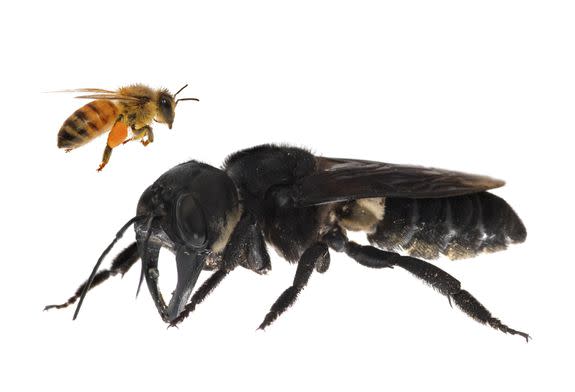The world's largest bee has been rediscovered, and it's HUGE

In January 2019, a clan of scientists and conservationists tramped through the torrid Indonesian forest in search of the Wallace's giant bee — a species that hadn't been spotted alive since 1981.
"Nobody had seen it since then," said Robin Moore, a biologist and communications director for the organization Global Wildlife Conservation, which funded the expedition. "It was feared extinct."
It wasn't. They found a female.
The female bee — the larger sex of the species Megachile pluto — isfour times the size of the typical European honeybee with a wingspan of 2.5 inches. It's the largest known bee on the planet. "This is the holy grail of bees," said Moore.
Related Video: Bees Can Do Math!

Image: Clay Bolt
The species is named for Alfred Russel Wallace, the enterprising naturalist who conceived the theory of evolution at the same time as Darwin (though Wallace's work was largely overshadowed by Darwin's). In 1858, Wallace ventured into Indonesia and described this extraordinary bee, characterizing it as a "large black wasp-like insect, with immense jaws like a stag-beetle."
Over the past few decades, dead bodies of the giant bees had been seen on the trade market, said Moore, but it was unknown if the species still existed. Now, Global Wildlife Conservation has the first live footage of the elusive critters, found on the North Moluccas Indonesian islands.
The big pollinators aren't easy to find. The bees burrow into mounds of soil built by termites, which hang on trees someeight feet off the ground or higher. To sleuth out the bees, the biologists had to find and stare at these mounds for 20 minutes at a time. The team scoured these brown mounds for four days with no luck.
SEE ALSO: George is dead and his species likely extinct. It’s the loss of a ‘crown jewel of evolution.’
"We all internally decided that we weren't going to find these bees," Eli Wyman, a Princeton University entomologist and bee expert who took part in the expedition, said in an interview.
"Sometimes we were certain that large beetles must surely be the bee, other times, we would stare for ages at termite mounds only to move on disappointed, with a growing sense that we’d never discover the creature of our obsession," added Clay Bolt, a natural history photographer, in a statement.
But on the expedition's fifth and final day, the search team passed a low hanging termite mound near the road. "We almost didn't even stop to look at it," said Wyman. "That turned out to be the magic nest."

Image: Simon robson
"It's pretty exciting," Becky Irwin, a biologist who researches plant-pollinator interactions at North Carolina State University, said of the discovery.
This rare find is especially significant, Irwin added, in light of there being a deluge of bad news about native bee and insect declines. "It's kind of nice to have a bee that's been rediscovered," Irwin, who had no role in the expedition, said.
Though, Irwin noted that it's challenging to know how most wild bee populations are doing because many are located in remote places. "We don’t have good records of their population abundance," she said.
The same can be said of Wallace's giant bee. "The real status of the bees is still unknown," said Wyman. The scientists' next mission is to return and survey their population numbers. If it turns out these giant bees are dwindling, it wouldn't be a great surprise.
"They don't really have any protection," said Moore. "They are targets for trade."

Image: Clay Bolt
As for why these bees are so giant, the jury is still out, said Wyman. It could be a case of island gigantism wherein species isolated on islands grow much larger than their mainland counterparts, sometimes due to a lack of predators. Or it could be that the larger bees were more fit to colonize and survive on a new island.
Whatever the reason, the bee's rediscovery illustrates that there are other "fantastical species" still out there that aren't widely known or haven't been seen in decades, said Moore.
Wallace's giant bee, for its part, lived only in museum collections, enticing curious entomologists to wonder if the creatures Alfred Wallace identified over 160 years ago still buzzed around in these remote humid forests. Until now.
"As soon as I saw the entrance of the nest, I knew immediately," Wyman said, referring to his first sight of the fated termite mound. "It was what I had pictured all these years."
WATCH: Major corporations are bracing for climate change



